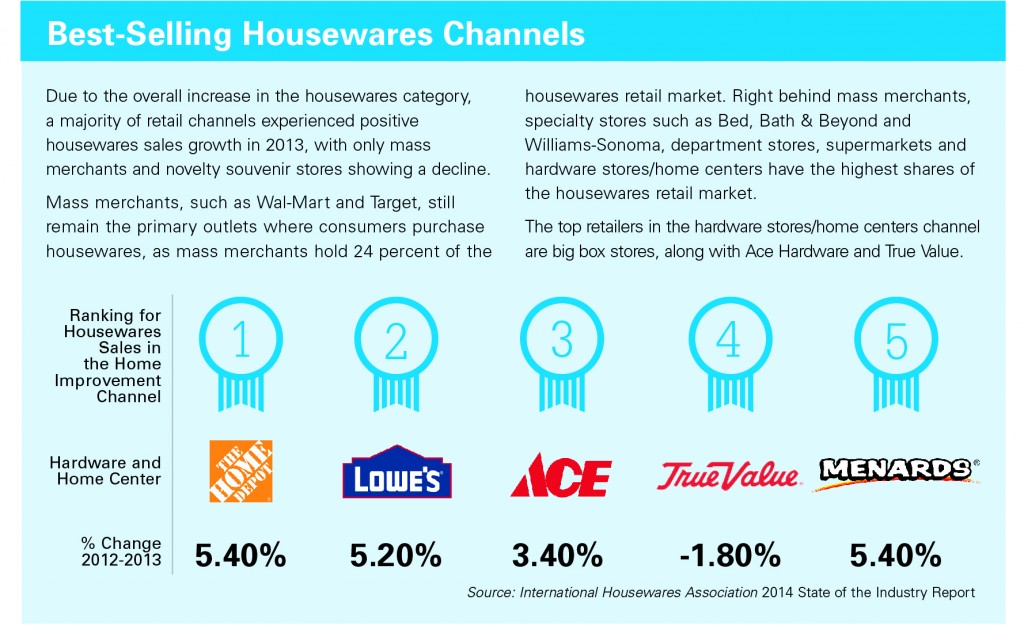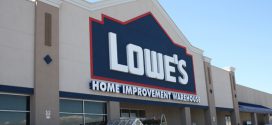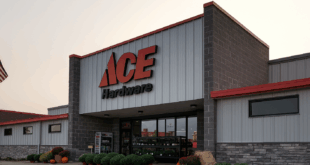To download a PDF of this story click here and to download the Housewares Selling Guide visit hardwareretailing.com/housewares-localgoods.
By Sara Logel, slogel@nrha.org and Renee Changnon, rchangnon@nrha.org
For many home improvement retailers, the housewares department is a great place to showcase new and exciting products, bring color and fun to the salesfloor and introduce customers to local goods that may be hard to find.

One competitive advantage local retailers have is the ability to add character and variety to inventory, and the housewares category is the perfect place to do so. In this article, we look at different ways you can spice up your housewares category and carefully craft your product selection to match the uniqueness of your independent store. To vary your product offerings effectively, we have included housewares category data from the International Housewares Association.
Additionally, Hardware Retailing editors visited Indianapolis businesses to see how retailers outside the industry partner with local vendors to create truly unique product presentations. Click here to view a video of their trip.
Housewares Picking Up Speed: A Quick Look at the Category
In this section, we look at the best-performing housewares product categories and how home improvement retail outlets rank in terms of housewares sales. This data was gathered from the International Housewares Association’s 2014 State of the Industry Report, the most recent annualized data available.
The complete 2014 State of the Industry Report can be downloaded here. Non-members can purchase the report for $500.
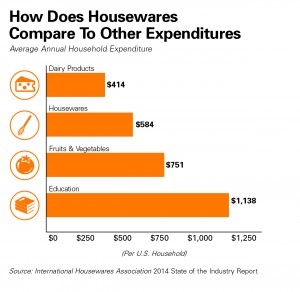 A Look at the Numbers
A Look at the Numbers
To put annual housewares spending in perspective, look at the chart below. Data provided by the U.S. government shows that the average U.S. household spends about $600 each year on housewares products. This amount is comparable to what consumers spend on basic staples such as dairy products, fruits and vegetables, and is nearly half of what they spend on education.
More consumers are purchasing home accessories, as U.S. housewares expenditures increased almost 6 percent in 2013. With this increase, the total housewares expenditures reached $73.4 billion, or $3 billion short of pre-recession levels. As the U.S. economy continues to grow and recover, consumers will regain purchasing power and likely become more confident spenders.
The housewares industry contains numerous products, from infant furniture to electric personal care products, all sorted into six different sectors. Due to this wide-ranging assortment, consumers purchase housewares items frequently.
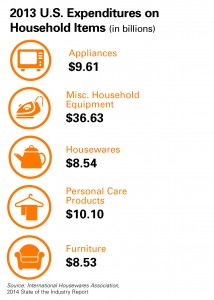 Best-Performing Product Categories
Best-Performing Product Categories
Similar to 2012, the top housewares categories of 2013 were cook and bakeware, kitchen tools and accessories, kitchen electrics and tabletop, which together constitute more than 50 percent of sales in the housewares industry.
When you look at the most popular items sold through home improvement stores, however, the story is slightly different. In home improvement stores, the best selling housewares categories are cleaning products and stick goods (brooms, mops, etc.). Hardware stores and home centers sold a collective $513 million in cleaning products and stick goods during 2013, nearly $80 million more than the second-ranked category of kitchen tools and accessories.
Rather than only supplying items from the best-performing product categories, consider unique products within other categories, such as closet organizers and personal care items.
This ever-evolving and broad category lends itself to sourcing from a variety of vendors. In the following pages, we will discuss how to capitalize on this category by sourcing through local vendors and integrating community retailers’ products into your operation.
To view an in-depth video of trends seen in the housewares category click here.
Local Goods Bring More to Housewares: Simple Strategies to Finding and Promoting Uniquely Local Products
During any weekend in the summer or early fall, community members in towns across the U.S. gather at their local farmers markets in search of locally sourced fruits and vegetables, hand crafted soaps, freshly picked flowers, handmade furniture, arts and crafts and much more.
As retailers work on making their housewares selections stand out against competition, taking a page from a typical farmers market may help generate new ideas and drive more customers through the doors.
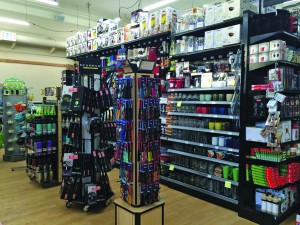
Independent retailers can compete against big box and speciality stores because of their ability to tailor their product selections to the local market, which mass merchants and large chains can’t do easily. The housewares category provides the local hardware store plenty of opportunities to source locally. While retailers should carry major brands and basic items, they can augment their selections with locally sourced goods. This does multiple things: It shows that independent retailers offer different selections than other stores and support their communities, and it keeps customers returning to the store to see what new local products retailers may add in the future.
Housewares is a category that offers a wide variety of products, and customers purchase the items most often based on wants rather than needs. Many of these products are gifts and specialty items.
In other departments, such as plumbing, customers may require a specific product to repair a leaky faucet and often need a particular brand to fix the problem. In housewares, however, there is more flexibility and freedom to try new things. Retailers should use this to their advantage and ask their customers what they would like to see, so they can continually introduce new products to the salesfloor.
Selling Local Goods in Housewares
At TAGS Hardware in Cambridge, Massachusetts, there are a variety of local goods available in the store’s housewares department, according to co-owner Simon Shapiro.
“Regionally made items we currently have in our inventory include Stonewall Kitchen products and Kupow, a cover that converts a canning jar to a travel mug,” Shapiro says.
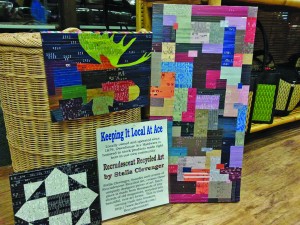
Another retailer with many local goods that draw in tourists and repeat customers is Owenhouse Ace Hardware in Bozeman, Montana. Local vendors add many unique items to the housewares department, from handmade pottery, dog toys, artwork, handmade picture frames, locally made wooden cutting boards and alpaca wool hats and socks, according to Tiffany Cardona, housewares department head at both store locations.
Cole Hardware in San Francisco also sells many locally sourced items that are in the housewares category, but the products often span several categories, according to marketing coordinator Julia Strzesieski.
“There are many local businesses we support. For example, GreenToys™ is a company that makes their toys out of recycled milk jugs from the Bay Area. One of the owners of the company has been a long-time customer at our flagship store,” Strzesieski says.
A few other local products available at Cole Hardware include candles, glue alternatives and even coffee from a local coffee roaster.
How to Partner With Local Vendors
Retailers looking to find local products to sell often need to look no further than a community farmers market. A farmers market is a great place to start when searching for local vendors that sell housewares items, according to Cardona from Owenhouse Ace Hardware.
“I would suggest going to farmers markets, especially if you’re looking for things in housewares,” Cardona says. “The majority of my local vendors do farmers markets, as well. If you want to add any kind of art or pottery, I would definitely go to a farmers market.”
While farmers markets are a great place to get started, there are several other ways to find local business partners. Partnering with local vendors can be simple and no different than many other vendor relationships. Often local vendors initiate conversations with local retailers to ask about forming partnerships.
TAGS Hardware is a large destination store, so many vendors seek out the store in the hopes of selling their locally made products to TAGS customers, Shapiro says.
“Our consumers are interested in locally sourced items, and I think our consumers are very interested in supporting local business efforts,” Shapiro says. “Local purveyors seek us out. If we think the item is viable, we will work with the individual to develop a marketing plan within the store.”
TAGS Hardware works with five or six locally sourced vendors each year, according to Shapiro.

Similar to TAGS Hardware, Owenhouse Ace Hardware is frequently approached by local vendors wanting the store to give their products a shot, Cardona explains.
“For the most part, we’ve been approached mainly because we have a really great location in a downtown area and a big front window,” Cardona says. “We get a lot of foot traffic, especially during the summer.”
At Cole Hardware, when customers see products from local businesses on the shelves, they are usually pretty interested, Strzesieski says.
“When local vendors approach us with a business idea, we’re always willing to give it a shot,” she says.
Setting up a local vendor at Cole Hardware is pretty simple, Strzesieski says. The staff adds the new SKUs to their system and then places an order, with the buying team typically completing the inventory setup.
In San Francisco, most of the local vendors Cole Hardware partners with are part of a trade organization called SF Made, Strzesieski says. The group promotes products made locally.
Many similar trade organizations exist in communities across the country. Retailers interested in reaching out to local vendors to start stocking locally made merchandise may want to begin by looking for an organization that represents the vendors.
Promote Local Goods
Once a retailer decides to sell one or a few local businesses’ products in-store, the next step is to work with the vendor on crafting a marketing plan to make customers aware of local offerings. The vendor may already have marketing material for their products that retailers can use in their stores.

Owenhouse Ace Hardware showcases local housewares products in the front window of the store, Cardona says.
“The front window is where I put most of the housewares items. I usually ask our local vendors to build displays for their products, especially if they’re going to go in the front window,” Cardona says.
Retailers should consider organizing products in a designated display area, in a prime window location or on an easily accessible endcap. One way to remind customers that these products are unique to the store and community is by utilizing signage that can give more insight into a product, offering more information about the business owner and stating where the product was made.
Another way retailers can help promote local goods is by inviting local vendors to host in-store workshops and talk about their products and how to use them. Introducing community members to other local business owners is a great way put a face to the makers of the products they purchase.
Independent Businesses Support Each Other
Integrating local goods in the housewares department provides another way to sell more products, build a brand and add to a store’s bottom line. Additionally, creating local partnerships can lead to community events and a network that strengthens the local economy and business community.
The housewares department is a great area of a store to get started selling locally sourced products. Retailers should keep their eyes open for opportunities and use their business sense to decide if a local vendor relationship will be mutually beneficial.
 Hardware Retailing The Industry's Source for Insights and Information
Hardware Retailing The Industry's Source for Insights and Information


